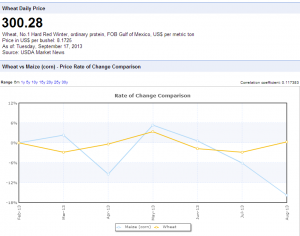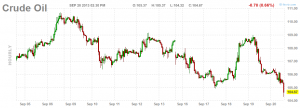The future trading of agricultural goods is a very fresh and challenging thing for me, I guess for most of us. Before I got to know my new friend—Stocktrak, it made me nervous with its profession and complexity. I have been at a loss until I “googled” concepts like what’s limit orders, what’s stop orders, what’s GTD and GTC, etc. After these steps, I finally became a little bit relieved. I found that the trading was similar to the precious metal trading I did during my undergraduate study. The principle is the same, buying at a lower price and selling at a higher price.
After information searching, I got to know some tips when trading for the future contract. A market order won’t be preferred when there’s a low average daily volume in the market. Because it tends to make you end up paying more than you originally anticipated. And the stop order will help you to execute at the price that you ask for, but not to guarantee the price. In other word, the order won’t guarantee your payment or receipts.
As a completely green hand, I tried to make my first trading for future by observing the past and current agricultural market. And the news told that the corn prices were down more than 3% after the USDA unexpectedly increased its corn yield estimates. And the agency is now predicting that 2012 would be the greatest yield since 2009. Maize, as an essential biofuel feedstock, has been experiencing volatility over the past few years. The fuel market has a strong impact on maize market. Compared with the rate of change in wheat’s price, that in maize’s price tends to be more unstable. (Graph1.1) Thus, for my first
trade, I tend to buy more wheat instead of corns. In this week, we can see that the change of the price of corns was more unstable than that of the price of wheat. Thus, I tried to figure out which factor had such an influence on corn’s price.
I found a piece of news on crude oil, there’s a 2.5% soar in the market. (Resource from: http://www.lse.co.uk/AllNews.asp?code=tcxm5f5q&headline=Crude_Oil_Surges_25_On_Fed_Decision_Supply_Data)It has resulted in the constantly drop of oil’s price. (Graph1.2) Will it correspondingly affect the price of agricultural commodities? Within this week, the price of maize has dropped dramatically since Sep.20. (Graph 1.3) Empirically, the change of the price of crude oil should be in line with that of corn and soybeans. And the fact is that the price of corns has been affected by the price of crude oil and still in the status of low prices. I’ll keep observing the price tendency of corns next week and find out other factors that will influence the market of corns.
In conclusion, the trade in this week was not good enough. But I tried to connect different sources of information with the agricultural market. As a freshman, I decided to make my decisions based on news and price tendency. Gradually, I’ll start to use more analysis tools and professional knowledge to make deals.
Vanilla Chen



